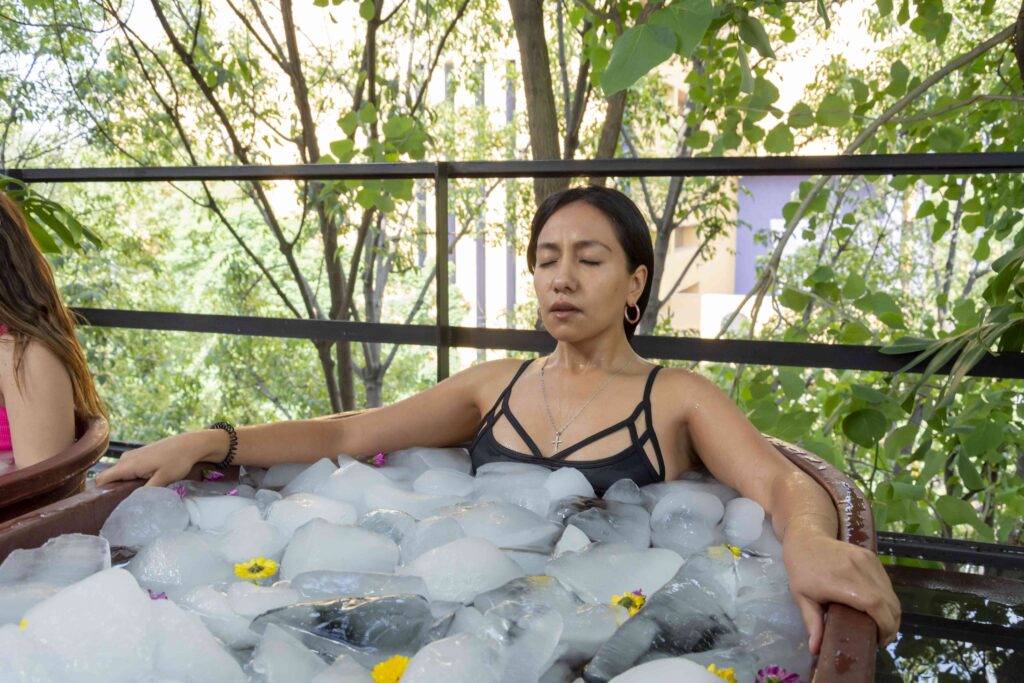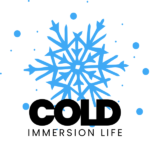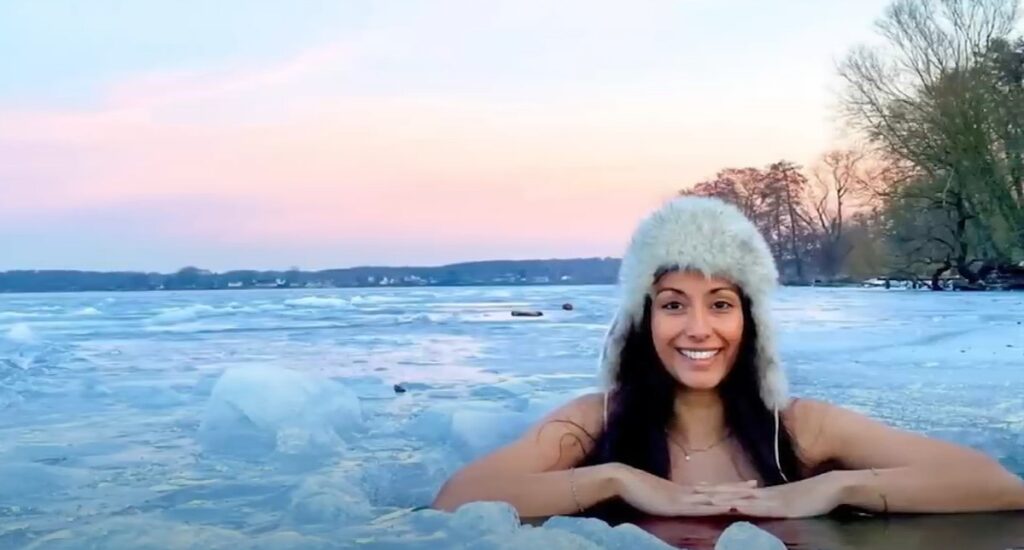Need help?
Unsure whether you need a bath or a plunge, portable or fixed, chiller or iced? Check out Sasha’s cold plunge vs ice bath article to answer all and get clarity on your cold immersion needs.

Imagine this: You’ve just wrapped up a long, stressful day, and as you look at your bed, you’re hoping for a night of deep, restful sleep. But then, reality kicks in, and you find yourself tossing and turning, unable to fully settle down. It’s a familiar struggle for many, but what if I told you there’s a simple ritual that could make all the difference? Cold plunges for better sleep quality might be the answer you’ve been seeking.
You’ve probably heard of cold plunges before — plunging your body into cold water, usually between 50°F and 59°F. Although it may sound daunting at first, cold plunges are gaining traction, not only for their physical recovery benefits but also for how they can significantly enhance your sleep quality. In this article, we’ll guide you through the world of cold plunge benefits, explain how they can improve your sleep, and introduce you to some effective products to get you started.
Contents
- 1 Why Cold Plunges Can Help Improve Sleep Quality
- 2 How to Incorporate Cold Plunges Into Your Routine
- 3 Best Practices for Cold Plunging
- 4 The Benefits You’ll Notice
- 5 What to Expect the First Time
- 6 Additional Tips to Enhance Your Sleep Quality
- 7 Frequently Asked Questions About Cold Plunges
- 8 Final Thoughts
Why Cold Plunges Can Help Improve Sleep Quality
To understand how cold plunges can help you sleep better, it’s important to know a bit about your body’s natural rhythm. Your body temperature naturally drops in the evening as part of your circadian rhythm, which is your internal clock that tells you when it’s time to sleep and wake up. Lowering your body temperature signals your brain that it’s time to rest, helping you fall asleep faster and stay asleep longer.
A cold plunge helps accelerate this cooling process, allowing your body to reach that “sleep-ready” temperature more quickly. The effect can be almost magical — as soon as you step out of that cold water, your blood vessels dilate, promoting relaxation, reducing inflammation, and ultimately leading to better sleep.
There’s even some science to back it up. Studies have shown that cold water immersion can reduce the levels of cortisol (your body’s stress hormone) while promoting the release of endorphins, which are the feel-good chemicals that help you feel calm and relaxed. This physiological shift can set the stage for a night of deep, quality sleep.
How to Incorporate Cold Plunges Into Your Routine
Incorporating cold plunges into your daily or weekly routine doesn’t have to be complicated. If you’re new to the practice, here are a few options you can consider:
- Cold Showers: The easiest way to get started is by switching your regular hot shower to a cold one, especially at night. You don’t have to go straight to the coldest setting; try gradually decreasing the temperature over time. Start with 30 seconds of cold and work your way up to 2-3 minutes. It’s a great introduction that can still provide significant benefits.
- Ice Baths: If you want to take things up a notch, try an ice bath. Fill your tub with cold water and add a few bags of ice until the temperature is around 50°F. Sit in the bath for 5-10 minutes before bedtime. It’s intense, but many people find that it provides a profound sense of calm afterward, making it easier to drift into sleep. For those looking for a dedicated tub for their cold plunge then take a look at Sasha’s best ice bath list for guidance.
- Cold Plunge Pools: For those committed to making cold plunges a regular part of life, investing in a dedicated cold plunge pool can be a game-changer. Take a look at Johnny’s best cold plunge list so you won’t make the wrong investment. These tubs maintain a consistent cold temperature, allowing you to immerse yourself whenever it’s most convenient.
- Portable Ice Baths: If you’re short on space, you can also consider one of Marcus’s portable ice baths options. They’re compact, easy to fill, and well-suited for those who need an affordable, space-saving solution.
Best Practices for Cold Plunging
It’s important to approach cold plunges with a bit of care. Jumping straight into cold water without preparation can be shocking, and while that’s part of the point, you still want to ensure you’re being safe. Here are some tips to keep in mind:
- Breathe Deeply: The initial shock of cold water will make you want to hold your breath, but resist that urge. Focus on deep, steady breaths to help your body adapt to the cold. Controlled breathing helps activate the parasympathetic nervous system, which is crucial for relaxation and preparing your body for sleep.
- Start Slow: If you’re new to cold plunging, start with a shorter duration. Just one to two minutes is enough to get some benefit, and you can gradually work your way up as your tolerance increases.
- Consistency Is Key: Just like any other health routine, consistency is important. Aim to take cold plunges 2-3 times a week to notice a significant impact on your sleep quality.
- Warm Up Slowly: After a cold plunge, it can be tempting to jump straight into a hot shower or wrap yourself in a blanket, but letting your body warm up naturally helps your nervous system stabilize and reinforces the positive effects on sleep.
The Benefits You’ll Notice
One of the first things you might notice after trying cold plunges for better sleep quality is that you fall asleep faster. Cold plunges activate your parasympathetic nervous system, which is responsible for the “rest and digest” state. This activation directly counters the fight-or-flight response that keeps you awake at night with racing thoughts.
People who cold plunge also report deeper sleep. That means you spend more time in restorative phases like deep sleep and REM, which are crucial for physical recovery, memory consolidation, and emotional processing. When you’re not constantly waking up or tossing and turning, your body can fully benefit from every minute of sleep.
What to Expect the First Time
The first time you do a cold plunge, it’s perfectly normal to feel a bit overwhelmed. The cold shock will trigger an automatic stress response — your heart rate will increase, and you might feel a wave of adrenaline. The key here is to remind yourself that this response is temporary and that your body will adjust.
Focus on your breathing. Try inhaling deeply for four counts, holding for four counts, and then exhaling for six to eight counts. This type of breathing helps to lower your heart rate and sends signals to your brain that you are safe. By the time you’re a minute or two in, you’ll likely start feeling a sense of calm, and when you finally step out, you’ll feel invigorated and clear-headed.
After your cold plunge, you’ll notice that your body feels refreshed, and your muscles might even feel more relaxed. This is because cold plunges help reduce inflammation and muscle tension — which are also major factors that can impact sleep quality.
Additional Tips to Enhance Your Sleep Quality
While cold plunges are a powerful tool for better sleep, they’re most effective when combined with other healthy sleep habits. Here are a few additional tips to maximize the quality of your sleep:
- Set a Consistent Sleep Schedule: Try to go to bed and wake up at the same time every day. This helps regulate your circadian rhythm and reinforces your body’s natural sleep-wake cycle.
- Limit Blue Light Exposure: Reduce screen time at least an hour before bed. Blue light from devices can disrupt melatonin production, making it harder for you to fall asleep.
- Create a Relaxing Sleep Environment: Make sure your bedroom is cool, quiet, and dark. Consider using a white noise machine or blackout curtains to create a sleep-friendly environment.
- Mindful Practices: Practices like meditation or yoga can help calm your mind before bedtime. These activities complement cold plunging by keeping your stress levels low.
Frequently Asked Questions About Cold Plunges
1. Is cold plunging safe for everyone?
Cold plunges are generally safe, but if you have cardiovascular issues or any pre-existing health conditions, you should consult a healthcare professional before trying them. The sudden drop in temperature can place a strain on your heart, so it’s always best to be cautious.
2. How long should I stay in a cold plunge?
If you’re just starting cold plunges for better sleep quality, even 1-2 minutes is enough. Over time, as you become more accustomed to the cold, you can extend the time to around 5-10 minutes. Always listen to your body—if you feel too uncomfortable or start shivering uncontrollably, it’s time to get out.
3. When is the best time to do a cold plunge?
For sleep benefits, the best time to take a cold plunge is in the evening, about an hour or two before bed. However, some people prefer doing it right after a workout or in the morning for an energy boost. Experiment and find what works best for you.
4. Can I combine hot and cold therapy?
Absolutely! Alternating between hot and cold (also known as contrast therapy) can provide additional benefits for circulation and relaxation. You could try alternating between a hot shower/sauna and a cold plunge, ending on cold to get the sleep-promoting effects. Check out Greg’s post for further details on combining hot and cold.
Final Thoughts
Cold plunges for better sleep quality may sound intimidating at first, but they can be incredibly rewarding — especially when it comes to enhancing your sleep quality. The combination of physiological benefits, such as reduced inflammation, lowered cortisol, and the activation of the parasympathetic nervous system, makes cold plunges a simple but powerful tool in your wellness toolkit.
If you’re ready to experience better sleep, why not give it a try? Start with a cold shower, or if you’re feeling adventurous, go for a full cold plunge. Remember to be patient with yourself as you adapt, and celebrate the small wins — like falling asleep a little bit faster or waking up feeling more refreshed. Cold plunging could be the missing link between you and the deep, restful sleep you’ve been dreaming of.
This website may contain affiliate links. As an affiliate, we may earn a commission from qualifying purchases at no additional cost to you.

